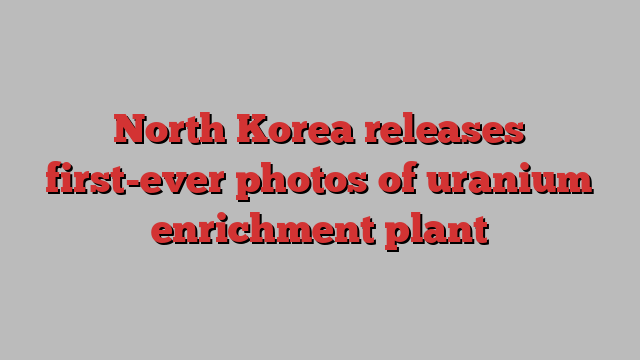
Unlock the Editor’s Digest for free
Roula Khalaf, Editor of the FT, selects her favourite stories in this weekly newsletter.
North Korea has released the first-ever images of a secretive uranium enrichment facility, offering a rare glimpse into the regime’s accelerating weapons programme as leader Kim Jong Un calls for increasing nuclear arms development.
State media on Friday said Kim visited the Nuclear Weapons Institute, a production base for weapons-grade nuclear materials. Pictures released by the official Korean Central News Agency show Kim touring rows of metal centrifuges used to enrich uranium and being briefed by North Korean scientists.
Kim expressed “great satisfaction” with the “technical force of the nuclear power field” and “stressed the need to further augment the number of centrifuges in order to exponentially increase the nuclear weapons for self-defence”, KCNA said.
He also called for North Korea to strengthen its defence and pre-emptive attack capabilities, warning that “anti-[North Korea] nuclear threats perpetrated by the US imperialists-led vassal forces have become more undisguised and crossed the red line”.
Kim has previously revised North Korea’s nuclear doctrine to allow pre-emptive strikes under a wide range of scenarios.
The reports did not specify when Kim toured the facility or where it was located. Kim also visited a military training base and supervised a multiple-rocket launch system this week, according to KCNA.
South Korea’s unification ministry condemned Pyongyang’s public disclosure of its uranium enrichment facility, saying on Friday that the regime’s “illegal” nuclear weapons programme posed a serious threat to international peace.
North Korea’s nuclear weapons programme is banned by numerous UN Security Council resolutions, but Pyongyang is believed to have several uranium enrichment sites in addition to the main known facility at Yongbyon.
In November 2010, regime invited scientists including US nuclear physicist Siegfried Hecker, a former director of the Los Alamos nuclear research laboratory, to tour its centrifuges at Yongbyon, where it reportedly claimed to have installed 2,000 centrifuges.
The Seoul-based Korea Institute for Defense Analyses estimated last year that North Korea had 80 to 90 nuclear warheads, and Kim was aiming to increase his nuclear stockpile to up to 300 weapons.
South Korean officials have warned that North Korea could conduct a nuclear test around the US presidential election in November. Pyongyang’s last nuclear test in September 2017, its sixth, was the most powerful yet, with an estimated yield of 120-125 kilotons.
“If North Korea pushes ahead with another nuclear test, despite the international warning, it will face unprecedented levels of deterrence and sanctions,” unification ministry spokesperson Koo Byoung-sam said.
Experts said North Korea had shifted its focus from enriching plutonium to uranium to expand its nuclear weapons arsenal.
“Given the production constraints with plutonium, North Korea has been relying on uranium enrichment, which is more effective for scaling up production of nuclear warheads,” said Kim Jae-chun, a professor at Sogang University and a former government adviser.
“With this kind of military muscle-flexing, North Korea wants to raise its profile ahead of the US election and gain the upper hand in future nuclear negotiations.”